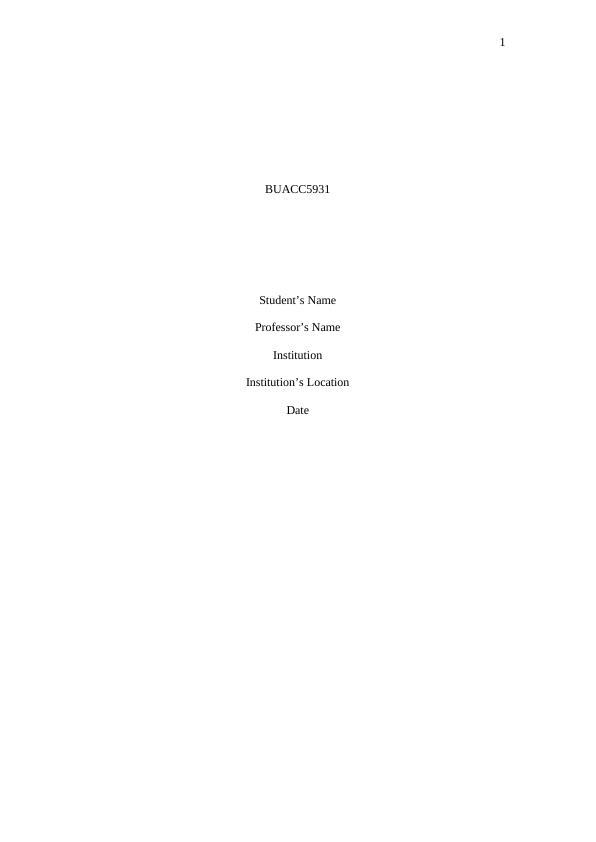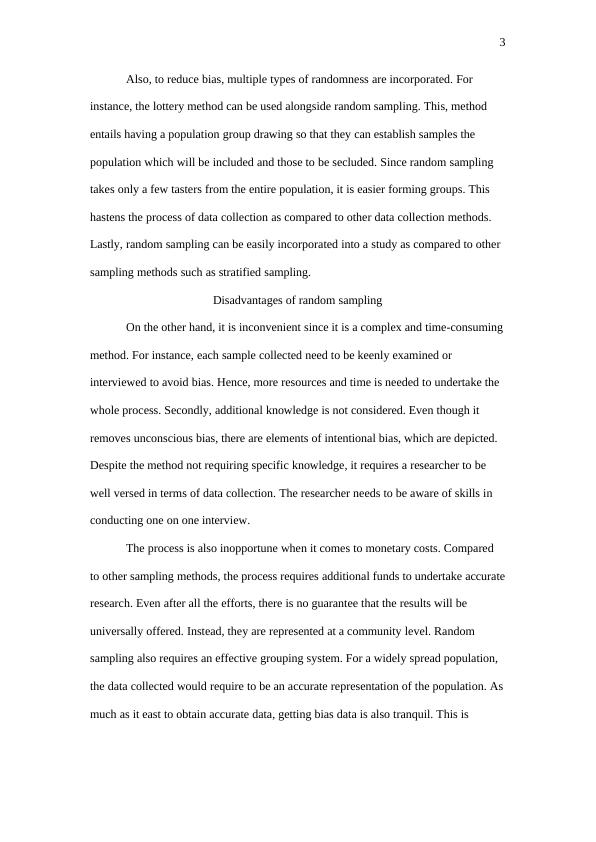Institution’s Location | Assignment
Added on 2022-10-04
9 Pages2295 Words18 Views
1
BUACC5931
Student’s Name
Professor’s Name
Institution
Institution’s Location
Date
BUACC5931
Student’s Name
Professor’s Name
Institution
Institution’s Location
Date

2
The sample size.
The sample size selected as appropriate for the research. This was about
15,000 employees, which is about 21 percent of the population. Since it had reached
the minimum percentage of 10 percent, the size was considerable. A higher
percentage of the sample size would increase the accuracy of the results (Emerson,
2015, pp.164-168). For instance, 21 percent would yield more reasonable results that
can be analyzed. The results will be used to represent the entire population of
employees in that firm. Thus, it would have met the required standards, which issue
acceptable outcomes.
Sampling method.
Since the samples were casually selected, the appropriate method chosen was
random sampling. This method gave chances to every employee in the bank from
every sector. As such, each bank unit was covered. Random sampling has numerous
advantages than it is disadvantageous. Below are the pros and cons of this method.
Advantages of random sampling.
Starting with the pros, the method is unbiased. There is an equal chance of
being selected. Since samples are selected without discrimination, the results
presented are neutral (Fischetti et al., 2016, pp.113-132). Each participant from
different sectors is given a chance. Hence, the entire population will be represented
fairly. Secondly, it is simple to incorporate into research work. Researchers do not
require many skills and knowledge in order to incorporate it in their activities. The
method is simple and direct. Random sampling also offers a chance to perform data
analysis with less risk of incurring errors. Since sampling occurs within specified
borders, the chosen sample would reflect an entire population with a motive of
providing views about detailed subject matters.
The sample size.
The sample size selected as appropriate for the research. This was about
15,000 employees, which is about 21 percent of the population. Since it had reached
the minimum percentage of 10 percent, the size was considerable. A higher
percentage of the sample size would increase the accuracy of the results (Emerson,
2015, pp.164-168). For instance, 21 percent would yield more reasonable results that
can be analyzed. The results will be used to represent the entire population of
employees in that firm. Thus, it would have met the required standards, which issue
acceptable outcomes.
Sampling method.
Since the samples were casually selected, the appropriate method chosen was
random sampling. This method gave chances to every employee in the bank from
every sector. As such, each bank unit was covered. Random sampling has numerous
advantages than it is disadvantageous. Below are the pros and cons of this method.
Advantages of random sampling.
Starting with the pros, the method is unbiased. There is an equal chance of
being selected. Since samples are selected without discrimination, the results
presented are neutral (Fischetti et al., 2016, pp.113-132). Each participant from
different sectors is given a chance. Hence, the entire population will be represented
fairly. Secondly, it is simple to incorporate into research work. Researchers do not
require many skills and knowledge in order to incorporate it in their activities. The
method is simple and direct. Random sampling also offers a chance to perform data
analysis with less risk of incurring errors. Since sampling occurs within specified
borders, the chosen sample would reflect an entire population with a motive of
providing views about detailed subject matters.

3
Also, to reduce bias, multiple types of randomness are incorporated. For
instance, the lottery method can be used alongside random sampling. This, method
entails having a population group drawing so that they can establish samples the
population which will be included and those to be secluded. Since random sampling
takes only a few tasters from the entire population, it is easier forming groups. This
hastens the process of data collection as compared to other data collection methods.
Lastly, random sampling can be easily incorporated into a study as compared to other
sampling methods such as stratified sampling.
Disadvantages of random sampling
On the other hand, it is inconvenient since it is a complex and time-consuming
method. For instance, each sample collected need to be keenly examined or
interviewed to avoid bias. Hence, more resources and time is needed to undertake the
whole process. Secondly, additional knowledge is not considered. Even though it
removes unconscious bias, there are elements of intentional bias, which are depicted.
Despite the method not requiring specific knowledge, it requires a researcher to be
well versed in terms of data collection. The researcher needs to be aware of skills in
conducting one on one interview.
The process is also inopportune when it comes to monetary costs. Compared
to other sampling methods, the process requires additional funds to undertake accurate
research. Even after all the efforts, there is no guarantee that the results will be
universally offered. Instead, they are represented at a community level. Random
sampling also requires an effective grouping system. For a widely spread population,
the data collected would require to be an accurate representation of the population. As
much as it east to obtain accurate data, getting bias data is also tranquil. This is
Also, to reduce bias, multiple types of randomness are incorporated. For
instance, the lottery method can be used alongside random sampling. This, method
entails having a population group drawing so that they can establish samples the
population which will be included and those to be secluded. Since random sampling
takes only a few tasters from the entire population, it is easier forming groups. This
hastens the process of data collection as compared to other data collection methods.
Lastly, random sampling can be easily incorporated into a study as compared to other
sampling methods such as stratified sampling.
Disadvantages of random sampling
On the other hand, it is inconvenient since it is a complex and time-consuming
method. For instance, each sample collected need to be keenly examined or
interviewed to avoid bias. Hence, more resources and time is needed to undertake the
whole process. Secondly, additional knowledge is not considered. Even though it
removes unconscious bias, there are elements of intentional bias, which are depicted.
Despite the method not requiring specific knowledge, it requires a researcher to be
well versed in terms of data collection. The researcher needs to be aware of skills in
conducting one on one interview.
The process is also inopportune when it comes to monetary costs. Compared
to other sampling methods, the process requires additional funds to undertake accurate
research. Even after all the efforts, there is no guarantee that the results will be
universally offered. Instead, they are represented at a community level. Random
sampling also requires an effective grouping system. For a widely spread population,
the data collected would require to be an accurate representation of the population. As
much as it east to obtain accurate data, getting bias data is also tranquil. This is

End of preview
Want to access all the pages? Upload your documents or become a member.
Related Documents
Associations between Quantitative and Qualitative Job Insecurity and Well-beinglg...
|10
|2549
|227
Research and Statistical Methods for Businesslg...
|7
|2298
|220
Sampling in Focus Groups and Interviewslg...
|6
|843
|309
Research and Statistical Methods of Businesslg...
|10
|2426
|370
Q1 Sample Size Selectionlg...
|10
|2595
|95
Introduction to Statistics Assignmentlg...
|5
|921
|338
